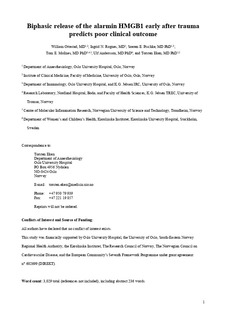| dc.contributor.author | Ottestad, William Arne | |
| dc.contributor.author | Rognes, Ingrid Nygren | |
| dc.contributor.author | Pischke, Søren | |
| dc.contributor.author | Mollnes, Tom Eirik | |
| dc.contributor.author | Andersson, Ulf | |
| dc.contributor.author | Eken, Torsten | |
| dc.date.accessioned | 2020-02-10T15:18:41Z | |
| dc.date.available | 2020-02-10T15:18:41Z | |
| dc.date.created | 2019-09-09T14:43:14Z | |
| dc.date.issued | 2019 | |
| dc.identifier.citation | Critical Care Medicine. 2019, 47 (8), e614-e622. | nb_NO |
| dc.identifier.issn | 0090-3493 | |
| dc.identifier.uri | http://hdl.handle.net/11250/2640864 | |
| dc.description.abstract | Objectives:
The causal role of the prototype alarmin high mobility group box 1 protein in systemic inflammation and remote organ injury after trauma and shock is established in animal models but not in humans. Our aim was therefore to determine high mobility group box 1 protein concentration kinetics with high time resolution during the first hours after trauma in individual patients and investigate the association with outcome.
Design:
Prospective single-center observational study.
Setting:
University hospital Level I trauma center.
Patients:
Convenience recruitment of 136 trauma patients.
Interventions:
None.
Measurements and Main Results:
Total plasma high mobility group box 1 protein levels were analyzed with enzyme-linked immunosorbent assay in repeated samples. Relationships between predefined predictor variables and outcome were examined in multivariable linear regression models. Ventilator-free days was used as primary outcome measure. Two distinct high mobility group box 1 protein release phases were identified. An initial exponential decay phase with half-life 26 minutes was not correlated with outcome. In contrast, a second high mobility group box 1 protein wave peaking 3–6 hours after trauma in the most severely injured and physiologically deranged patients was consistently the most important predictor of outcome in our multivariable models, rendering all other predictor variables insignificant except for smaller contributions from age and sex, and of admission base excess for maximal creatinine concentration.
Conclusions:
High mobility group box 1 protein was released in two consecutive phases. Only the second high mobility group box 1 protein wave was a significant predictor of outcome. Patients with a high high mobility group box 1 protein concentration between 3 and 6 hours after trauma might hypothetically benefit from high mobility group box 1 protein-specific antagonist therapy. | nb_NO |
| dc.language.iso | eng | nb_NO |
| dc.publisher | Lippincott, Williams & Wilkins | nb_NO |
| dc.title | Biphasic release of the alarmin high mobility group box 1 protein early after trauma predicts poor clinical outcome | nb_NO |
| dc.type | Journal article | nb_NO |
| dc.type | Peer reviewed | nb_NO |
| dc.description.version | acceptedVersion | nb_NO |
| dc.source.pagenumber | e614-e622 | nb_NO |
| dc.source.volume | 47 | nb_NO |
| dc.source.journal | Critical Care Medicine | nb_NO |
| dc.source.issue | 8 | nb_NO |
| dc.identifier.doi | 10.1097/CCM.0000000000003800 | |
| dc.identifier.cristin | 1722898 | |
| dc.description.localcode | © 2019. This is the authors' accepted and refereed manuscript to the chapter. Locked until 31.8.2020 due to copyright restrictions. The final authenticated version is available online at: http://dx.doi.org/10.1097/CCM.0000000000003800 | nb_NO |
| cristin.unitcode | 194,65,15,0 | |
| cristin.unitname | Institutt for klinisk og molekylær medisin | |
| cristin.ispublished | true | |
| cristin.fulltext | original | |
| cristin.fulltext | preprint | |
| cristin.qualitycode | 2 | |
